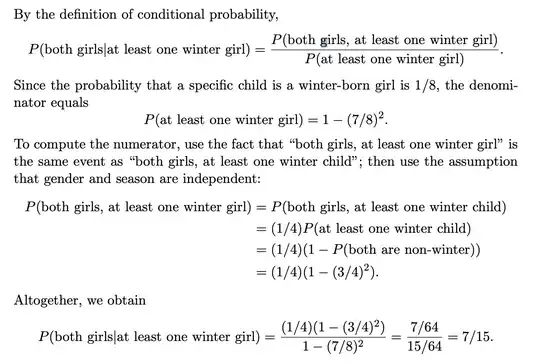This is one of those problems that is susceptible to a simple table of events.
In the table below, the row labels on the left are the possible events for the first child: $G_1$ if a girl, $B_1$ if a boy, $W_1$ born in winter, $P_1$ born in spring, $S_1$ born in summer, $F_1$ born in the fall.
The column labels are the possible events for the second child, using the same letters as labels but with the subscript $2.$
Each of the 64 cells of the table under the column labels has (we assume) equal probability, since we assume male and female births equally likely, births in each season equally likely, season and sex are independent, and the births of the two children are independent.
All cells that satisfy "both girls, at least one winter girl" are labeled $A.$
The exact same set of cells satisfy
"both girls, at least one winter child": there is no other cell where both children
are girls and at least one child was born in the winter.
If you doubt this, check all the other cells and see whether any of them is an event in which both children are girls and at least one child was born in the winter.
\begin{array}{c|cccccccc}
{} & G_2W_2 & G_2P_2 & G_2S_2 & G_2F_2 & B_2W_2 & B_2P_2 & B_2S_2 & B_2F_2 \\ \hline
G_1W_1 & A & A & A & A & C & C & C & C \\
G_1P_1 & A & D & D & D & E & E & E & E \\
G_1S_1 & A & D & D & D & E & E & E & E \\
G_1F_1 & A & D & D & D & E & E & E & E \\
B_1W_1 & C & E & E & E & F & F & F & F \\
B_1P_1 & C & E & E & E & F & F & F & F \\
B_1S_1 & C & E & E & E & F & F & F & F \\
B_1F_1 & C & E & E & E & F & F & F & F
\end{array}
If the event $A$ comprises exactly the cells labeled $A,$ event $C$ comprises exactly the cells labeled $C,$ and so forth, we have
\begin{align}
A & = \text{both girls, at least one winter girl;} \\
A \cup C & = \text{at least one winter girl;} \\
\end{align}
and by simple counting it is easy to confirm that $P(A) = 7/64$
and $P(A\cup C) = 15/64.$
All the other calculations in the given solution are easily checked as well,
although it is not really necessary to make a table to do so.
For example, one of the implicit steps in the given solution is
$$
\mathsf P(\text{both girls, at least one winter child})
= \mathsf P(\text{both girls}) \mathsf P(\text{at least one winter child}),
$$
which follows directly from the assumption that the seasons of birth are independent of the sexes of the children.
(In the next step we substitute $\mathsf P(\text{both girls}) = 1/4,$
and that step is explicitly shown in the solution.)
For comparison, the classic two-girls problem hinges on these events:
\begin{align}
A \cup D & = \text{both girls;} \\
A \cup D \cup C \cup E & = \text{at least one girl.} \\
\end{align}
Taking away the "winter" condition allows some additional probability of two girls
(cells labeled $D$), but it also allows a lot more additional probability of just one girl (cells labeled $E$).
